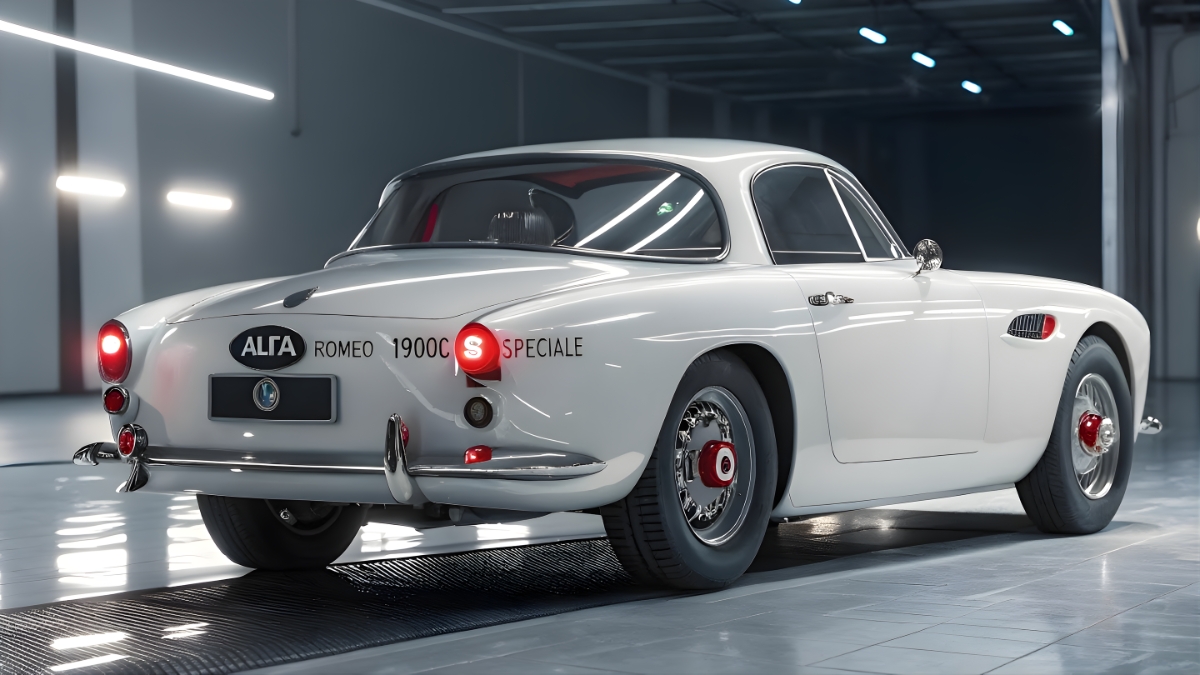Join on WhatsApp
Get the latest updates directly on WhatsApp – motivation, news & more!
The Alfa Romeo 1900C SS Speciale (where “C” stands for Corto, or short wheelbase, and “SS” means Super Sprint) was built in the mid-1950s as part of Alfa’s effort to blend racing performance with elegant Italian design. What makes this particular version stand out is that it was bodied by Ghia, one of Italy’s most respected design houses.
Unlike mass-produced vehicles, this was a handcrafted one-off or extremely limited-run creation. Each curve and line was meticulously shaped by artisans, not machines. The result was a car that looked like a sculpture in motion smooth, balanced, and effortlessly stylish.
This model symbolized Italy’s post-war renaissance in both engineering and artistry, representing the country’s return to luxury craftsmanship after years of industrial struggle.
When and How the 1900C SS Speciale Was Born Explained Simply
The Alfa Romeo 1900 series debuted in 1950 as Alfa’s first car built entirely on a production line. But the brand quickly realized that wealthy customers wanted something more exclusive. That’s when they started supplying bare chassis to famous Italian coachbuilders Touring, Pininfarina, Zagato, and Ghia to create custom bodies.
By 1955, Ghia designed the 1900C SS Speciale, turning a powerful Alfa chassis into a rolling piece of art. The car combined the 1900 Super Sprint’s 2.0-liter inline-four engine, capable of around 115 horsepower, with lightweight bodywork that made it both fast and elegant.
It wasn’t just a show car it could reach speeds of up to 120 mph, an impressive feat for the 1950s.
| Feature | Details |
|---|---|
| Year Built | 1955 |
| Designer | Carrozzeria Ghia |
| Engine | 1,975 cc Inline-4 |
| Power Output | Approx. 115 HP |
| Top Speed | ~120 mph (193 km/h) |
| Production | Extremely limited (believed to be one-off or very few made) |
Why the Ghia Design Makes This Alfa Romeo So Special
The Ghia-designed 1900C SS Speciale was different from anything else on the road at that time. Ghia’s chief designer, Giovanni Savonuzzi, was known for his futuristic approach favoring flowing shapes, rounded fenders, and aerodynamic lines inspired by jet aircraft.
This influence is clear in the Speciale’s teardrop silhouette, long hood, and low, wide stance. The car’s wraparound windshield and sculpted rear fenders gave it a sense of motion even when parked.
It’s a blend of elegance and aggression a balance that few carmakers have achieved since. Collectors often describe it as “functional art,” where engineering and beauty coexist in perfect harmony.
How the 1955 Alfa Romeo 1900C SS Speciale Performs Power & Feel Explained
While the Speciale looks like it belongs in a museum, it was designed to drive as impressively as it looked. The 1900C SS chassis was already well-known for its agility, thanks to independent front suspension and responsive steering.
Under the hood, the 2.0-liter DOHC inline-four delivered lively acceleration. Paired with a 5-speed manual gearbox, it provided a thrilling, tactile driving experience that modern cars can rarely replicate. The lightweight Ghia body meant it could keep up with or even outperform larger, more powerful cars of the era.
Drivers loved its precise handling, balanced weight distribution, and the unmistakable sound of its rev-happy Alfa engine.
Common Mistakes When Restoring or Collecting This Model
Owning or restoring a 1955 Alfa Romeo 1900C SS Speciale is a dream for many, but there are challenges that come with such rarity.
- Authenticity verification is crucial many replicas or modified versions exist. Always check chassis and engine numbers.
- Original parts are extremely difficult to source, especially Ghia-specific trim or interior pieces.
- Over-restoration can harm value collectors prefer cars that retain as many original materials as possible.
- Documentation matters cars with full provenance (factory papers, build history, exhibition records) fetch far higher prices at auction.
When in doubt, work with classic Alfa specialists or consult the Alfa Romeo Register before making major restoration decisions.
The Legacy and Collector Value of the 1900C SS Speciale
Today, the 1955 Alfa Romeo 1900C SS Speciale is considered one of the most desirable post-war Alfa Romeos ever built. Because it’s either a one-off or one of only a handful, its value is almost impossible to quantify.
At auctions, similar coachbuilt Alfas have sold for $1 million to $2.5 million, depending on condition and history. The Speciale’s rarity, combined with Ghia’s craftsmanship, ensures it remains a centerpiece for elite collectors and concours events like Pebble Beach or Villa d’Este.
More than a car, it’s a work of art that embodies Italy’s golden design era and that’s something that transcends generations.
Conclusion
The 1955 Alfa Romeo 1900C SS Speciale is not just a vintage automobile it’s a masterpiece that defines what Italian automotive artistry truly means. Born from Alfa’s racing spirit and Ghia’s visionary design, it remains a timeless reminder of when cars were built with soul, passion, and imagination.
In 2025 and beyond, its legacy continues to inspire designers and car lovers alike proving that true beauty never fades.
FAQs About 1955 Alfa Romeo 1900C SS Speciale
1. When was the Alfa Romeo 1900C SS Speciale built?
It was created in 1955, based on the 1900C Super Sprint chassis and designed by the Italian coachbuilder Ghia.
2. Why is the Ghia-designed version so rare?
Because it was likely a one-off or part of an extremely limited series, built specifically to showcase Ghia’s design mastery.
3. What engine does the 1900C SS Speciale have?
It’s powered by a 2.0-liter inline-four engine producing around 115 horsepower, paired with a manual transmission.
4. How much is the 1955 Alfa Romeo 1900C SS Speciale worth today?
Depending on provenance and condition, it could be valued between $1 million and $2.5 million at major collector auctions.
5. Can the 1900C SS Speciale still be driven today?
Yes, most restored examples are fully drivable, though they’re usually preserved for shows, exhibitions, or private collections.
